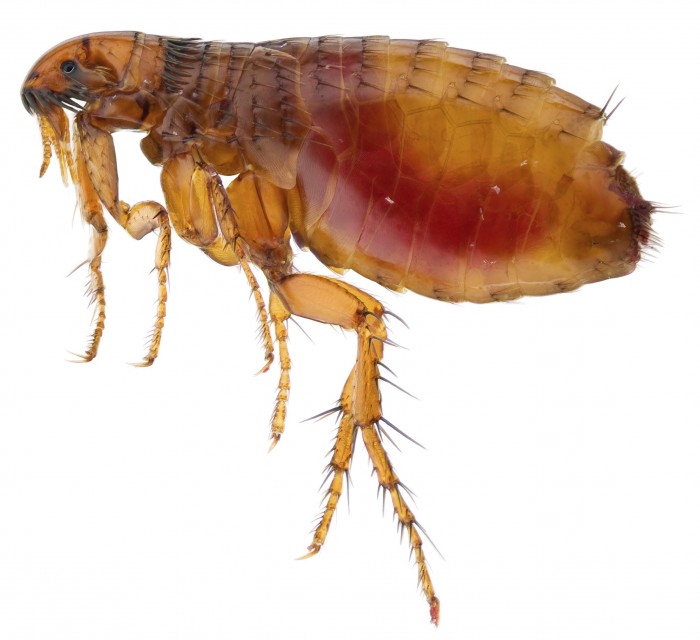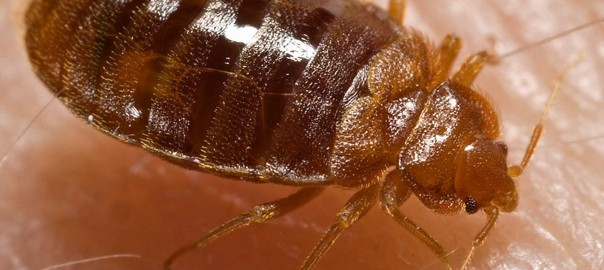Do you suspect you may have a bed bug infestation in your home? Or is your pet suffering from fleas and you would like more information about these pests and how they can be treated? Then read on for our helpful answers to some frequently asked questions about bed bugs and fleas.

1. What are bed bugs and what do they do?
Bed bugs are small, oval parasites that feed on human blood. Aptly named, bed bugs live around the seams of mattresses and headboards. However, these pests can also live in small, dark spaces; this includes the back of furniture, a chest of drawers and even a crack in the wall. The reddish-brown insect measures at around 5mm in length and can leave bites all over the body, in which can cause great irritation, escalating when scratched.
2. How can I tell if I have a bed bug infestation?
There are a few indications that you may have an infestation of bed bugs in your home, including the following:
Bites – If you are regularly finding yourself covered with small, red marks and they swell or itch when scratched, it is likely you have a bed bug infestation, as these pests feed on sedentary or sleeping humans.
Checking your mattress and headboard – It is important to check your mattress, headboard and bed frames thoroughly for signs of both the small, black bugs and their eggs. Bed bugs often leave behind small, black traces in which can be identified as faeces, or sometimes rust-coloured stains are left on mattress tags and seams.
Sweet odours – When there is a large colony of bed bugs, they will tend to emit a sickly sweet almond smell. Bed bugs produce these chemicals in which help them to communicate, thus leaving an odour. It is important to note however, that not everyone will be able to notice the smell, and a sweet odour is dependent on a particularly large infestation present.
Eggs and exoskeletons – Bed bugs have an outer shell that they shed and leave behind. If you see shell-like remains on your mattress, this can be a strong indication you are suffering from a bed bug infestation. There can also be eggs present in which female bed bugs lay in small crevices. These appear to be white and oval shaped, and can be difficult to spot considering bed bugs measure at approximately 5-7 millimetres.
Black marks around your home – If you have noticed the appearance of black marks and dirt on skirting boards, flooring, walls, and around the seams of mattresses and headboards in your property, this is a sure sign that you may have a bed bug infestation that needs the attention of an expert pest controller.
3. How can bed bugs be treated?
It is advised that bed bugs are to be treated by a trained pest controller. This is because vacuuming alone will not remove the pests. Initially, a pest controller will assess the severity of the bed bug infestation, noting the areas in the household or commercial property that will need to be treated. After this, a water-based insecticide spray will be used to eradicate the infestation, bed bugs can contaminate an entire property so it is important that as much of the area possible is treated.

4. Why is it important to treat bed bugs immediately?
It is important when a bed bug infestation is discovered in a household or commercial property, that they are treated as soon as possible. This is because bed bugs can spread throughout your home rapidly, and what may initially have been an infestation in one room can potentially spread throughout the entire premises, proving to be more costly and difficult to eliminate.
5. How long will the premises need to be vacated for after treatment?
It is important that the treated premises is vacated for at least four hours after the treatment. This is because bed bugs can contaminate an entire property, therefore it is very important that as much of the area as possible is treated. Those that are pregnant, have babies or young children or even those with breathing difficulties such as asthma, will be at a greater risk from the treatment, although the pest controller will advise these customers on how long they should vacate the premises for.
6. What are fleas and what do they do?
Fleas are parasitic insects that feed on blood. Measuring at approximately 1-3mm in length and reddish brown to black in colour; they have six long legs which enable them to jump great distances, leaving bites on humans and other mammals, including household pets. Their bodies are flat without wings and completely covered in hair, allowing for quick movement and the ability to root themselves to the host with ease.
7. What is the life cycle of a flea?
Measuring at just 0.5mm, fleas start their life as eggs living on your pets hair coat, hatching within just 2-5 days. After hatching, these eggs then begin to form a larvae, beginning life at around 1-2mm long. Larvae feed off flea dirt and debris in the environment, and are hardly seen. Larvae eventually spin cocoons within the carpet fibres for pupation. Pupae can lie dormant for up to 12 months before re-emerging and infesting your household pet. They are stimulated to emerge as adult fleas from components such as vibration, an increase in temperature or carbon dioxide. Most commonly, fleas emerge from 1-4 weeks, and can begin feeding within hours of finding a cat or dog. However, the flea can only survive a short time without feeding if it is dislodged from its host.
8. How can I tell if I have a flea infestation?
Some of the most effective ways to identify a flea infestation in your home or commercial property can include:
- Experiencing numerous flea bites. These are generally below the waist but in severe circumstances can be all over the body.
- Checking your pets for any flea bites on the skin and noticing any eggs present.
- Identifying small, reddish-black bugs around your household or commercial property.
9. Why is it important that a professional pest controller is used to treat an infestation?
It is important that a pest controller treats an infestation to ensure that the pest problem is fully eradicated, and to prevent any further infestation. A fully trained, professional pest controller will have full training and expertise in the handling of pesticides and extermination of pests, and will be able to assess the infested property, to ensure the best steps are taken for the pest problem to be completely resolved quickly and efficiently.
10. How do I know if my household pet is carrying fleas?
It is important to regularly check your household pets for fleas to avoid an infestation. A strong indication that your pet is carrying fleas can include spotting any flea bites or eggs on the skin, additionally if your pet seems to be scratching more than usual, this can be a sign they are suffering from fleas. Household pets can carry these pests even in the most spotless of homes, therefore it is important to notice the signs and apply flea medication regularly.
11. What diseases can fleas transmit to my household pet?
There are a number of diseases in which fleas can transmit to your household pet, with many causing serious health issues. Just some of the diseases fleas can cause include:
- Haemobartonellosis – This is a disease that affects the red blood cells in household pets, causing anemia in cats. Other symptoms of this disease include a loss of appetite and dramatic weight loss.
- Plague – If a flea has previously bitten an infected animal, and proceeds to bite your pet, this can spread the plague and result in symptoms such as a fever and even sudden death.
- Tapeworms – Tapeworms can be spread to your pet if a flea that is carrying tapeworm eggs is eaten. The tapeworm eggs will then hatch and attach itself to your pets intestines, resulting in great irritation, vomiting and weight loss.
- Cat Scratch Disease (CSD) – Owners in particular can be at risk from this type of disease, as fleas transmit CSD from one cat to another. Humans can get CSD when infected flea faeces is transmitted from the pet to the owner through a bite, lick or scratch.
12. How can I prepare the premises to ensure the fleas are treated effectively?
In order for the flea infestation to be treated completely and effectively, it is firstly important to consider if you own any household pets and ensure they are treated with a flea medication prior to the pest controller tending to the infestation. This is to eliminate any possibilities of further infestation and to ensure your household pet is not carrying and spreading fleas in your home. It is additionally important that the infested rooms are cleared of any clutter such as furniture, as well as other soft furnishings being removed and washed at the highest possible temperature in order to kill any remaining pests.
If you have a pest infestation in your home or commercial business, always be sure to use a reputable pest control company to ensure pests are treated safely and effectively. We recommend TDC Pest Control, a nationwide pest control company operating 24 hours* a day, 365 days* a year.




